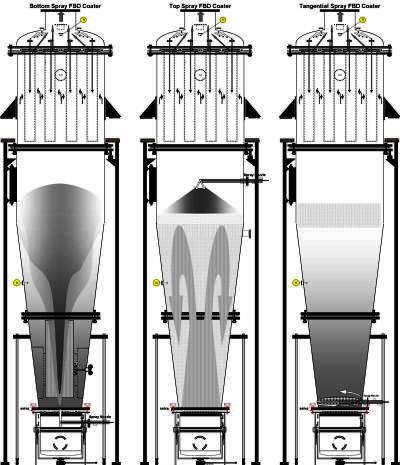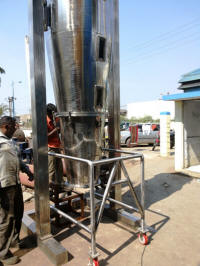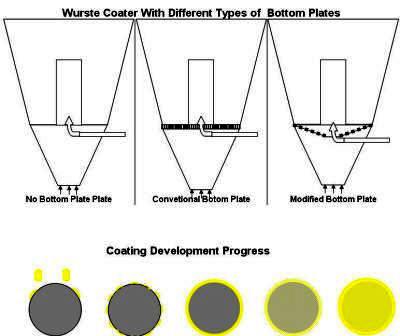Technology of Fluidized Bed Wurster Coating, Process Parameters, Principles and Scale up.

Spray
Coating with Fludized Bed
Top-Spray Coating
This processing option is a very elementary one. A perfect film is generally
not expected for this function.
Bottom-Spray Coating
The Bottom Spray Coating called Wurster fluid-bed process is a technology
for precision application of high quality reproducible films onto
particulate materials such as powders, crystals, or granules. The technology
can be used to encapsulate solid materials with diameters ranging from near
20µm to more than a centimeter with high quality reproducible films and
highly organized particle flow. For film coating the bottom-spray process
produces a smoother and more uniform coating and higher coating efficiency
compared with top-spraying or tangential-spraying.
Tangential Spray Coating
This processing similar to bottom-spray coating, only that the production
motion is provided by a motor driven rotor disc. Uniform and desired
residence time is achieved by rotor revolution speed. The rolling
motion of the particles provides an even higher separation force, as such
preventing agglomeration. However, this high movement makes it difficult to
coat very small particles and is generally destructive for larger and
non-spherical products.
Wurster coating process or technology was invented by Dr. Dale Wurster at University of Wisconsin in 1950s. Hats-off to him for conceiving this method at a time when neither coating process nor fluidized bed drier was a routine item. The basic concept in a Wurster coater or air suspension coater, which can be classed as a precision coater is to separate the particles from one another in a heated air or gas stream and spray a coating formulation onto the particles while they are suspended. Wurster Coater is also called Particle Coating Machine
A Wurster coating machine is not something an engineer learns during his academic study. It hardly has a mention in the text books. To overcome this shortcoming, an attempt is made here to explain the details of the same. The principle and technology of Wurster coater is covered here and all the theory and process parameters are explained.
Film coating processes require evaporative removal of an organic solvent or aqueous medium as the film coat is deposited. The speed of a film coat application is related to the drying capacity of the process. Fluid-bed film coating processes have a greater drying capacity than other coating systems due to a high fluidizing air volume that is used to both circulate particles and evaporate the coating resulting in more efficient film coat application. This process can be done for both aqueous and non-aqueous applications. This process is capable of handling solvents, suspensions, emulsions, aqueous solutions films and hot melts. It has been used for coating small particles, tablets, pellets and capsule with batch sizes from a few hundred grams to few hundred kilograms. This process is particularly suitable for a controlled release or extended release and delayed/enteric coating of active ingredients. In this process, a complete sealing of the surface can be achieved. The Wurster fluid-bed process is a technology for precision application of high quality reproducible films onto particulate materials such as powders, crystals, or granules. The technology can be used to encapsulate solid materials with diameters ranging from near 20µm to more than a centimeter with high quality reproducible films and highly organized particle flow.
The Wurster fluid-bed coating process is well suited to uniformly coat or
micro-encapsulate individual particles.
It consists of a spray nozzle at the bottom of a fluidized bed of solid
particles.
The particles move with fluidizing air upward past the spray nozzle. There
is a central cylindrical partition and the bottom plate has holes in such a
way that most of the air passes from the center, creating a venturi-effect.
The nozzle sprays atomized coating solution or suspension concurrently with
particle flow. Passing particles move upward into an expansion chamber as
droplets deposit on their surfaces.
The expansion chamber reduces air velocity to allow particles to circulate
back to the coating chamber. It also allows particles to further separate
from one another temporarily and minimize the potential for particle
agglomeration.
The organic solvent or aqueous coating medium is evaporated as the particles
move through the expansion chamber leaving non-volatile coat formulation
ingredients on the particle surface developing film coat.
The operating parameters are adjusted so that the coating dries while the
particles are suspended in order to prevent agglomeration from occurring
when they enter the fluidized bed. This process is continued until each
particle is coated uniformly to the desired coat percentage or film
thickness.
The Wurster fluid-bed process can also be used to apply a hot melt coating
such as a wax.
The Wurster system combines a coating partition and perforated air distribution plate to organize the flow of particle.
The Wurster machine consists of a conical product container with perforated disc at the bottom. Inside the product container there is a cylinder called coating partition, which is raised slightly above the perforated disk. This partition is having a system of adjusting the gap from the bottom plate.
In the centre of the plate spray nozzle is fitted below the coating partition which is used to dispense the coating solution.
The perforated disc has large hole under the coating partition and one ring at the perimeter and smaller holes at the remainder of the plate. Due to this design, venturi effect is created in the center. Particles are accelerated upward through the coating partition, and downward outside this partition. The particles passing through the coating partition receives a layer of coating material, and dries in the expansion chamber and falls back. During each pass through the coating partition the substrate particles receives an increment of coating material. The particles circulate rapidly in this fashion and cycles are repeated, perhaps several hundred times depending on the coating thickness desired. The operating parameters are adjusted so that the coating dries while the particles are suspended in order to prevent agglomeration from occurring when they enter the fluidized bed. The quality of film coat applied can be controlled by monitoring key process and product variables. Wurster coaters are particularly suited to scale-up from lab-scale to production systems. Critical design parameters include chamber geometry, air velocity and mass flow ratio of air to product. Typically, the depth of the fluidized bed is kept constant in order to maintain similar coating depth and particle density over the scale-up range.
Process
variables
Batch size: 30% to 90%
of volume external to coating partition must be occupied by the particles to
be coated. This makes it possible to have sufficient quantity of particles
inside the partition to accumulate the maximum coating solution droplets and
to avoid premature drying, or depositing on the walls of the partition.
Air Distribution Plate or Bottom Plate:
Suitable base plate has to be select to get consistent fluidization at
minimum attrition.
Adjustable Wurster Partition: The height of the wurster partition is
adjustable for ensuring better particle distribution in the draft tube for
better coating.
Fluidization Air Flow: The
inlet air volume is required to dry the product it and to achieve desired
fluidization pattern.
Fluidization Air Temperature:
For aqueous solvent high temperature is needed to avoid agglomeration
of particles while for non-aqueous solvent low temperature is ok as they get
dried at low temperature also. Too high temperature can also cause
agglomeration and fracturing of coated film. So the temperature is adjusted
after considering the various properties of substrate as well as of solvent
media. Generally <50°C for organic and 80°C for aqueous solutions are
useful.
Spray Rate: In Wurster binary nozzle
are used. The droplet formation, spreading, coalescence and evaporation
happen almost simultaneously during the process. The spray rate depends on
the core particles as well as the solution properties.
Nozzle:
To avoid agglomeration in wurster coater the coating fluid is to be
finely atomized. Large droplets of coating fluid generated by low
performance nozzle do not distribute evenly over the material to be coated
and do not dry quickly as smaller droplets. Very small droplets may dry
quickly. Some droplets may contact tablets or beads surface but may dry
before getting spread, it will result in to the irregular surface on core
material.
Atomization Air:
If the atomization pressure is high then the mist size will be lower,
then the chances of agglomeration will also low. Excess pressure will lead
to a particle shooting to the filter bag. The atomization pressure varies
from 2 bars to 4 bars. During the optimization of spray rate to achieve
fastest possible process, one should keep droplet very small. Higher the
pressure smaller will be droplet. An explanation
of Wurster Coating Spray
Nozzles is attached.
Product variables
Particle size:
If the specifications set for the core is not
rigid enough and if the average particle size of core varies, it will lead
to considerable change in the film thickness with same % coating.
As the particle size decreases the
amount of coating material require for desire thickness becomes very high.
So it suggested using large particle size that may reasonably produce the
desired results. Best way is to use as uniform particles as is practical to
procure.
Particle surface:
If the particle surface will rough the total
coating area available for coating will change.
Solution Viscosity and Concentration:
We have to reduce the spray rate if the solution is viscous and
tacky. It is generally known that, higher solid content will reduce the
process time.
We are manufacturers of Wurster Coating Machine complete Machine in SS316. Complete machine with air filter, heat exchanger, product container, filter, cyclone, blower, compressor Instrumentation & PLC and the working platform is offered on turn-key basis. Our buyers staff will be trained on our working machine. The offer will not be vague with many extras as every thing will be included.
Please visit our pages on Wurster Coating Fluidized Bed Equipment or Machine.
The models offered will be compatible for converting it to use as Top-spray Granulator or as Fluidized Bed Drier.
Machines are offered in various ranges:
Laboratory Wurster Coater from 1 liter per batch to 10 liters per batch a
single machine with interchangeable product bowl is good enough in the
entire range.
Small Wurster Coater of 25 liters/batch, 50 liters/batch, 100 liters/batch a
single machine with interchangeable product bowl is good enough in the
entire range.
Plant Scale Wurster Coater 200 liters/batch, 400 liters/batch, 600
liters/batch, 800 liters/batch, 1000 liters/batch. Please visit sale purchase offer
for wurster coating machine.For calculating the batch size in kg use the formula: 90% of Volume in
liters*Bulk Density of product. Select a size not more than 3
times the minimum batch size that you anticipate (Better still 2 times the
minimum batch size that you anticipate).
We undertake Wurster Coating Job Work or Contract Manufacturing.

250 liter bowl capacity
5.5m height machine being fitted.
Click on the picture to enlarge.
Please send your enquiry to ajk@wurstercoating.com.
Wurster Coating Company
Ankleshwar Gujarat and Mumbai Maharashtra, India.
Every thing about Wurster Coating Process Parameters, Principle and Scale
up will be covered here.
We can encapsulate all the chemicals. We offer encapsulated chemicals as under:
Encapsulated Ammonium Persulfate & Potassium Persulfate Gel Breaker Manufacturers
Encapsulated Choline Bitartrate
Encapsulated Ferric Pyrophosphate
Encapsulated Magnesium Sulfate
Encapsulated Monosodium Phosphate
Encapsulated Potassium Citrate
Encapsulated Sodium Bicarbonate
Encapsulated Sodium Bromate Gel Breaker
More Chemicals from Anmol Chemicals Industries Private Limited.
6-may-22
